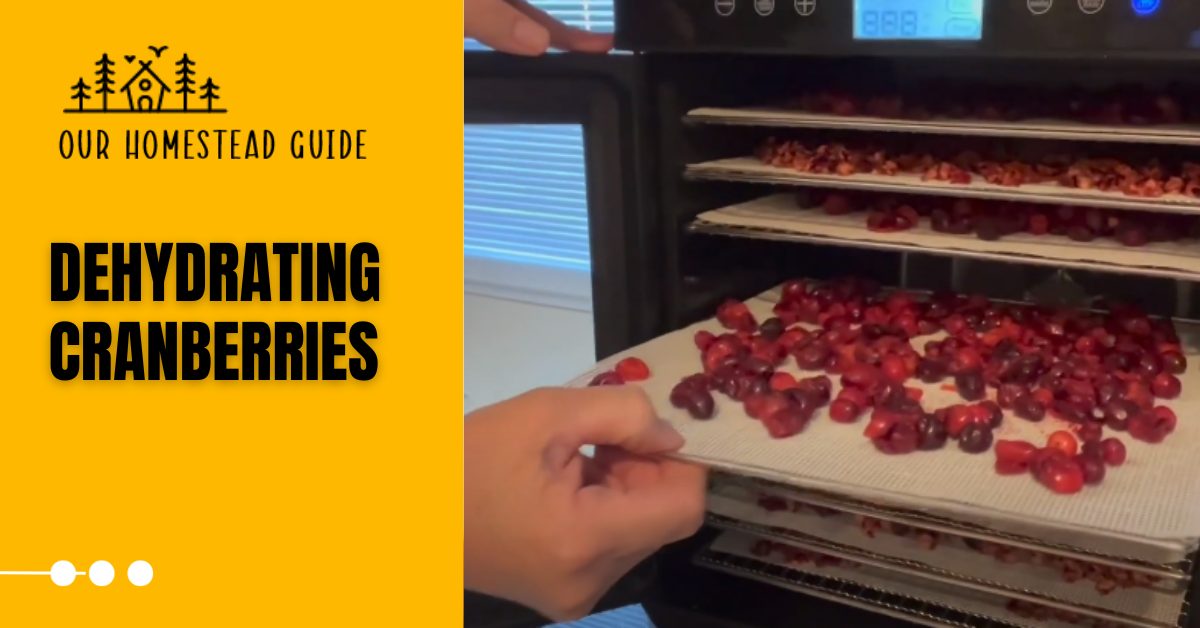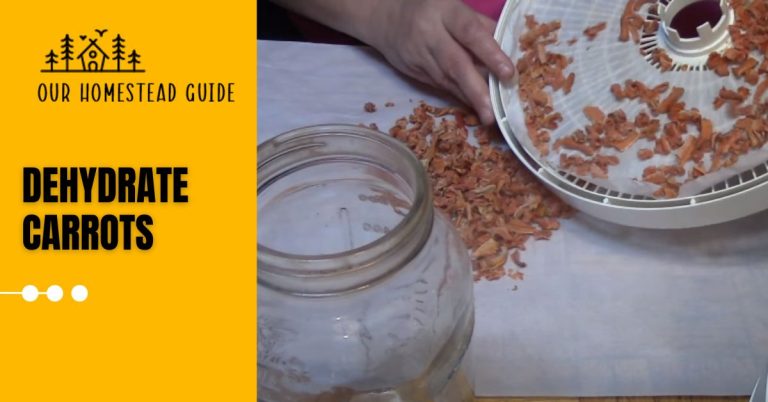Best Guide to Dehydrating Cranberries: Preserving & Storing Food
Dehydrating Cranberries, noted for their flexibility and nutritional value, can be used to enhance a variety of culinary creations, from refreshing salads to delightful baked sweets. Consider dehydrating cranberries if you want to keep them fresh and enjoy their flavor throughout the year.
Dehydrating Cranberries We’ll delve into the topic of cranberry dehydration in this all-inclusive guide, including numerous processes, serving suggestions, nutritional insights, and more. Let us begin this journey!
How to Dehydrate Cranberries?
With fresh berries and a dehydrator or oven, dehydrating cranberries at home is simple. Clean, examine, and sweeten to taste. Set the dehydrator or oven to low heat and dehydrate for 8-12 hours, or until the texture is malleable. Store in an airtight jar for use in recipes or as a tasty snack all year.
Ingredients:
You’ll only need two ingredients for this cranberry dehydration recipe: fresh cranberries and water. These fresh cranberries will be the foundation for your homemade dried cranberries, with water added for optional sweetening or rinsing the cranberries before the dehydration process begins.
Dehydrating Cranberries You can commence on the voyage of preserving the bright flavors of cranberries for extended enjoyment with these few but crucial items.
Wash the cranberries:
To prepare cranberries for dehydration, wash them thoroughly, removing dirt and contaminants. Rinse in cold water, and inspect for any branches or debris. This crucial step ensures clean and fresh cranberries, resulting in perfectly dried fruit with a flavorful burst.
Blanch the cranberries (optional):
Dehydrating Cranberries Blanching the cranberries is an optional step that can improve the dehydration process. Bring a kettle of water to a boil before carefully adding the fresh cranberries. Blanch cranberries in boiling water for 1-2 minutes to soften the skins for efficient drying.
After blanching, cool them in an ice water bath to halt cooking. This optional step can enhance the smooth and quick drying of the cranberries.
Drain and dry:
After blanching or choosing not to, prepare cranberries for dehydration. Drain them thoroughly, gently jiggling to aid drainage. Wipe cranberries dry with a kitchen towel for efficient dehydration, ensuring properly dried cranberries with enhanced flavor for the next step.
Arrange on trays:
After washing and drying, place cranberries on dehydrator trays, leaving enough space between them. Optimal spacing encourages even drying, which is necessary for tasty, shelf-stable dried cranberries. Proper tray placement is critical for versatility in a variety of recipes.
Set the temperature:
Set the dehydrator to 135°F (57°C) or the oven to the lowest possible temperature, about 170°F (77°C). Cranberries should be dehydrated for 8-12 hours to get a leathery texture. Cranberries that have been properly dried keep their color and flavor, making them ideal for a variety of culinary applications.
Cool and store:
Dehydrating Cranberries Allow the dehydrated cranberries to cool completely before storing them once they have attained the required leathery texture. This cooling phase prevents any residual moisture from producing condensation inside the storage containers, which could result in spoiling.
After cooling, store dried cranberries in airtight containers, eliminating extra air to ensure a longer shelf life. Keep cold, dry, and in a dark area. When properly kept, handmade dried cranberries remain fresh for an extended amount of time, ready for use in recipes or as a healthful snack.
Tips and Tricks:
- Those who prefer a little sweeter flavor in their dried cranberries could soak the cranberries in apple juice before dehydrating them. This step not only adds a wonderful hint of sweetness to the cranberries but also infuses them with a delicate apple undertone. Place the fresh cranberries in a jar and cover with apple juice, allowing them to soak for 30 minutes to an hour.
- Dehydrating Cranberries After soaking, rinse the cranberries thoroughly to remove extra liquid before placing them on dehydrator trays or oven baking sheets. This optional step gives your homemade dried cranberries a unique touch, giving a balanced blend of acidic and sweet flavors.
- Consider brushing a little sugar or dripping honey over your dried cranberries before dehydrating them for a lovely candied twist. Dehydrating Cranberries This simple addition will create a sweet and slightly sticky covering, increasing the flavor character of the cranberries. Experiment with this novel method for adding a wonderful burst of sweetness to your homemade dried cranberries.
- proper storage is essential for maintaining the freshness and flavor of dehydrated cranberries. Store them in sealed containers in a cool, dark place like a pantry to protect them from moisture and light. This ensures their long-lasting taste, ready to enhance your dishes whenever you use them.
- Consider using vacuum-sealed bags to keep your dehydrated cranberries fresh for longer. Dehydrating Cranberries These specialized bags aid in the removal of excess air, preventing moisture and air from damaging the flavor of the cranberries. You can enjoy the delicious flavor and flexibility of dried cranberries for an extended period of time by vacuum-sealing them.
Dehydrating Cranberries at Home:
Whether you’re using an air fryer, oven, or dehydrator, we’ve got you covered with detailed methods:
Air Fryer: While air fryers are primarily intended for hot air circulation cooking, certain versions do have a dehydrating function. If your air fryer has this option, you might be able to dehydrate cranberries with it. However, not all air fryers are designed for dehydration, so check the handbook or specifications of your appliance to determine if it has this feature.
Oven: Yes, Dehydrating Cranberries you may dehydrate cranberries in the oven at low temperatures for an extended period of time.
Dehydrator: Dehydrating cranberries in a specialized food dehydrator is an efficient and simple technique.
Alternative Methods: Cranberries may be dehydrated in a variety of ways, giving you the freedom to fit your cooking equipment and tastes. The fundamental concepts remain the same whether you use a food dehydrator, oven, or even an air fryer with a dehydration function: wash, prepare, arrange, dehydrate, chill, and store.
Dehydrating Cranberries Each approach has its own quirks, so pick the one that best suits your kitchen layout and accessible resources. Whatever path you choose, you’ll be rewarded with delicious homemade dried cranberries to add to your dishes and enjoy all year.
Serving Ideas: Delicious Ways to Enjoy Dehydrated Cranberries
Dehydrated cranberries are a versatile ingredient.
Dehydrated cranberries have a plethora of culinary applications. Incorporate these delectable dried cranberries into your meals and snacks, such as trail mixes for a quick burst of sweetness, baked goods for a tangy twist, salads for a chewy texture, yogurt parfaits for a savory contrast, and homemade granola bars for a delightful chewiness.
Dehydrating Cranberries You can use these serving suggestions to explore the versatility of dehydrated cranberries and improve a variety of recipes.
Processing: Various Approaches to Cranberry Dehydration
From blanching to using various liquids for soaking, explore different techniques for processing cranberries before dehydration.
There are various processing processes to consider when preparing cranberries for dehydration. Blanching, for example, is the technique of temporarily soaking cranberries in hot water to soften their skins and speed up the drying process.
Another method is to soak the cranberries in liquids such as apple juice or sugar syrup before dehydrating them to infuse them with taste and sweetness. These different cranberry processing processes allow you to personalize their taste and texture to your preference, allowing you to make unique and tasty dried cranberries for your culinary creations.
Health Benefits of Fresh Cranberries
Because of their rich nutritional profile and unique phytochemical composition, fresh cranberries provide a number of health advantages. Fresh cranberries may provide the following health benefits:
1-Antioxidant-rich foods:
Cranberries include antioxidants such as vitamin C, quercetin, and anthocyanins. These substances aid in the neutralization of free radicals in the body, hence reducing oxidative stress and inflammation.
2-Health of the Urinary Tract:
Cranberries have long been known for their ability to reduce urinary tract infections (UTIs). They include proanthocyanidins, which may help prevent some bacteria, such as E. coli, from sticking to the urinary tract walls, lowering the risk of infection.
3-Cardiovascular Health:
Cranberries’ antioxidants may benefit cardiovascular health by lowering inflammation and enhancing blood vessel function. According to several research, eating cranberries on a daily basis may help decrease blood pressure and improve cholesterol levels.
4-Anti-Inflammatory Effects:
Chronic inflammation has been related to a number of health issues, including heart disease and some malignancies. Cranberries’ antioxidants and phytochemicals may help control the inflammatory response and contribute to anti-inflammatory benefits overall.
5-Digestive Wellness:
Cranberries’ dietary fiber can improve digestive health by reducing constipation and promoting a healthy gut microbiota. Fiber also leads to a sensation of fullness, which can help with weight loss.
6-Cancer Avoidance:
According to certain research, the antioxidants in cranberries may have anti-cancer potential. They may assist in suppressing cancer cell proliferation and lower the risk of some forms of cancer.
7-Immune System Aid:
Cranberries’ strong vitamin C concentration benefits the immune system. Vitamin C is essential for collagen formation and helps the immune system operate properly.
8-Dental Care:
Cranberry compounds may help limit the adhesion of germs to the teeth, particularly Streptococcus mutans, thereby lowering the incidence of dental plaque buildup and cavities.
9-Weight Control:
Cranberries’ fiber content, along with their low calorie and sugar content, makes them a nutritious snack option that can help with weight management.
Most Frequently Asked Questions!
1- Why should I dehydrate cranberries?
Dehydrating cranberries extends their shelf life, increases their flavor, and produces a convenient snack or component for a variety of dishes.
2-How do I choose fresh cranberries for dehydration?
Choose cranberries that are firm, plump, and vividly colored. Soft or wrinkled ones should be avoided since they may not dehydrate well.
3 Do I need to wash cranberries before dehydrating them?
Yes, washing cranberries well before dehydrating is recommended to eliminate any debris or residue. You may rinse them in a colander with cold water.
4-Do I need to cut or slice cranberries before dehydrating?
Is it necessary to chop or slice the cranberries before dehydrating them?
While not required, chopping or slicing cranberries might assist in accelerating the dehydration process and make them more appropriate for specific recipes.
5 What equipment do I need for dehydrating cranberries?
A food dehydrator or a low-temperature oven will be required. For oven drying, you can also use a baking sheet or parchment paper.
6-What is the optimal temperature for dehydrating cranberries?
Set your dehydrator or oven to a low setting, ideally 135°F (57°C). The low heat preserves the nutritious value of the cranberries.
7-How long does it take to dehydrate cranberries?
Dehydration duration varies, but it usually takes 8 to 12 hours. Keep an eye on them and check for dryness on a regular basis.
8-How can I tell if cranberries are fully dehydrated?
Cranberries that have been dehydrated should be dry, slightly chewy, and wrinkled. They should not be sticky or damp.
9-Can I add sweetener before dehydrating cranberries?
To increase sweetness, mix cranberries in a little syrup or sprinkle with sugar before dehydrating. If you want to use them in recipes later, keep the extra sugar level in mind.
10-How should I store dehydrated cranberries?
Keep them cold and dark in sealed containers. To keep them fresh, vacuum-seal bags or jars work nicely.
11-What recipes can I use dehydrated cranberries in?
Cranberries that have been dehydrated can be added to cereals, granola, trail mix, baked products, and salads, or rehydrated and used in sauces. They’re adaptable and offer a taste boost to a variety of recipes.
12-Can I rehydrate dehydrated cranberries?
Yes, by soaking them in water, juice, or other liquids, you may rehydrate them. This is especially handy if you want to use them in recipes that call for plump, juicy cranberries.
you may also like this article.
Dehydrated Celery Delights: Creative Uses for Your Dried Stalks







